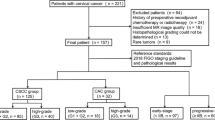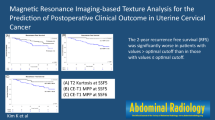Abstract
Objectives
To evaluate the diagnostic potential of diffusion kurtosis imaging (DKI) functional maps with whole-tumor texture analysis in differentiating cervical cancer (CC) subtype and grade.
Methods
Seventy-six patients with CC were enrolled. First-order texture features of the whole tumor were extracted from DKI and DWI functional maps, including apparent kurtosis coefficient averaged over all directions (MK), kurtosis along the axial direction (Ka), kurtosis along the radial direction (Kr), mean diffusivity (MD), fractional anisotropy (FA), and ADC maps, respectively. The Mann-Whitney U test and ROC curve were used to select the most representative texture features. Models based on each individual and combined functional maps were established using multivariate logistic regression analysis. Conventional parameters—the average values of ADC and DKI parameters derived from the conventional ROI method—were also evaluated.
Results
The combined model based on Ka, Kr, MD, and FA maps yielded the best diagnostic performance in discrimination of cervical squamous cell cancer (SCC) and cervical adenocarcinoma (CAC) with the highest AUC (0.932). Among individual functional map derived models, Kr map–derived model showed the best performance when differentiating tumor subtypes (AUC = 0.828). MK_90th percentile was useful for distinguishing high-grade and low-grade in SCC tumors with an AUC of 0.701. The average values of MD, FA, and ADC were significantly different between SCC and CAC, but no conventional parameters were useful for tumor grading.
Conclusions
The whole-tumor texture analysis applied to DKI functional maps can be used for differential diagnosis of cervical cancer subtypes and grading SCC.
Key Points
• The whole-tumor texture analysis applied to DKI functional maps allows accurate differential diagnosis of CC subtype and grade.
• The combined model derived from multiple functional maps performs significantly better than the single models when differentiating tumor subtypes.
• MK_90th percentile was useful for distinguishing poorly and well-/moderately differentiated SCC tumors with an AUC of 0.701.




Similar content being viewed by others
Abbreviations
- ADC:
-
Apparent diffusion coefficient
- CAC:
-
Cervical adenocarcinoma
- CC:
-
Cervical cancer
- CI:
-
Confidence interval
- DKI:
-
Diffusion kurtosis imaging
- FA:
-
Fractional anisotropy
- FIGO:
-
International Federation of Gynecology and Obstetrics
- ICC:
-
Inter-class correlation coefficients
- IQR:
-
Interquartile range
- Ka:
-
Kurtosis along the axial direction
- Kr:
-
Kurtosis along the radial direction
- MAD:
-
Mean absolute deviation
- MD:
-
Mean diffusivity
- MK:
-
Apparent kurtosis coefficient averaged over all directions
- PCC:
-
Pearson correlation coefficients
- rMAD:
-
Robust mean absolute deviation
- RMS:
-
Root mean squared
- ROI:
-
Region of interest
- SCC:
-
Cervical squamous cell cancer
- VOI:
-
Volume of interest
References
Bray F, Ferlay J, Soerjomataram I, Siegel RL, Torre LA, Jemal A (2018) Global cancer statistics 2018: GLOBOCAN estimates of incidence and mortality worldwide for 36 cancers in 185 countries. CA Cancer J Clin 68:394–424
Atahan IL, Onal C, Ozyar E, Yiliz F, Selek U, Kose F (2007) Long-term outcome and prognostic factors in patients with cervical carcinoma: a retrospective study. Int J Gynecol Cancer 17:833–842
Pimenta JM, Galindo C, Jenkins D, Taylor SM (2013) Estimate of the global burden of cervical adenocarcinoma and potential impact of prophylactic human papillomavirus vaccination. BMC Cancer 13:553
Lee SI, Atri M (2019) 2018 FIGO staging system for uterine cervical cancer: Enter cross-sectional imaging. Radiology 292:15–24
Bhatla N, Berek JS, Cuello FM et al (2019) Revised FIGO staging for carcinoma of the cervix uteri. Int J Gynaecol Obstet 145:129–135
Balcacer P, Shergill A, Litkouhi B (2019) MRI of cervical cancer with a surgical perspective: staging, prognostic implications and pitfalls. Abdom Radiol (NY) 44:2557–2571
Moukarzel LA, Angarita AM, VandenBussche C et al (2017) Preinvasive and invasive cervical adenocarcinoma: preceding low-risk or negative pap result increases time to diagnosis. J Low Genit Tract Dis 21:91–96
Fan A, Zhang L, Wang C, Wang Y, Han C, Xue F (2017) Analysis of clinical factors correlated with the accuracy of colposcopically directed biopsy. Arch Gynecol Obstet 296:965–972
Kuang F, Ren J, Zhong Q, Liyuan F, Huan Y, Chen Z (2013) The value of apparent diffusion coefficient in the assessment of cervical cancer. Eur Radiol 23:1050–1058
Padhani AR, Liu G, Koh DM et al (2009) Diffusion-weighted magnetic resonance imaging as a cancer biomarker: consensus and recommendations. Neoplasia 11:102–125
Xue H, Ren C, Yang J et al (2014) Histogram analysis of apparent diffusion coefficient for the assessment of local aggressiveness of cervical cancer. Arch Gynecol Obstet 290:341–348
Liu Y, Ye Z, Sun H, Bai R (2013) Grading of uterine cervical cancer by using the ADC difference value and its correlation with microvascular density and vascular endothelial growth factor. Eur Radiol 23:757–765
Jensen JH, Helpern JA, Ramani A, Lu H, Kaczynski K (2005) Diffusional kurtosis imaging: The quantification of non-gaussian water diffusion by means of magnetic resonance imaging. Magn Reson Med 53:1432–1440
Wang F, Chen HG, Zhang RY et al (2019) Diffusion kurtosis imaging to assess correlations with clinicopathologic factors for bladder cancer: a comparison between the multi-b value method and the tensor method. Eur Radiol 29:4447–4455
Zhu L, Pan Z, Ma Q et al (2017) Diffusion kurtosis imaging study of rectal adenocarcinoma associated with histopathologic prognostic factors: preliminary findings. Radiology 284:66–76
Wang M, Perucho J, Chan Q et al (2020) Diffusion kurtosis imaging in the assessment of cervical carcinoma. Acad Radiol 27:e94–e101
Wang P, Thapa D, Wu G, Sun Q, Cai H, Tuo F (2018) A study on diffusion and kurtosis features of cervical cancer based on non-Gaussian diffusion weighted model. Magn Reson Imaging 47:60–66
Meng N, Wang X, Sun J et al (2020) Application of the amide proton transfer-weighted imaging and diffusion kurtosis imaging in the study of cervical cancer. Eur Radiol 30:5758–5767
Gatenby RA, Grove O, Gillies RJ (2013) Quantitative imaging in cancer evolution and ecology. Radiology 269:8–15
Davnall F, Yip CS, Ljungqvist G et al (2012) Assessment of tumor heterogeneity: an emerging imaging tool for clinical practice? Insights Imaging 3:573–589
Castellano G, Bonilha L, Li LM, Cendes F (2004) Texture analysis of medical images. Clin Radiol 59:1061–1069
Tan Y, Mu W, Wang XC, Yang GQ, Gillies RJ, Zhang H (2020) Whole-tumor radiomics analysis of DKI and DTI may improve the prediction of genotypes for astrocytomas: a preliminary study. Eur J Radiol 124:108785
Li T, Hong Y, Kong D, Li K (2020) Histogram analysis of diffusion kurtosis imaging based on whole-volume images of breast lesions. J Magn Reson Imaging 51:627–634
Zhang Q, Peng Y, Liu W et al (2020) Radiomics based on multimodal MRI for the differential diagnosis of benign and malignant breast lesions. J Magn Reson Imaging 52:596–607
Wang J, Wu CJ, Bao ML, Zhang J, Wang XN, Zhang YD (2017) Machine learning-based analysis of MR radiomics can help to improve the diagnostic performance of PI-RADS v2 in clinically relevant prostate cancer. Eur Radiol 27:4082–4090
He M, Song Y, Li H et al (2020) Histogram analysis comparison of monoexponential, advanced diffusion-weighted imaging, and dynamic contrast-enhanced MRI for differentiating borderline from malignant epithelial ovarian tumors. J Magn Reson Imaging 52:257–268
Bickelhaupt S, Jaeger PF, Laun FB et al (2018) Radiomics based on adapted diffusion kurtosis imaging helps to clarify most mammographic findings suspicious for cancer. Radiology 287:761–770
Winfield JM, Orton MR, Collins DJ et al (2017) Separation of type and grade in cervical tumours using non-mono-exponential models of diffusion-weighted MRI. Eur Radiol 27:627–636
Ciolina M, Vinci V, Villani L et al (2019) Texture analysis versus conventional MRI prognostic factors in predicting tumor response to neoadjuvant chemotherapy in patients with locally advanced cancer of the uterine cervix. Radiol Med 124:955–964
Wang K, Cheng J, Wang Y, Wu G (2019) Renal cell carcinoma: preoperative evaluate the grade of histological malignancy using volumetric histogram analysis derived from magnetic resonance diffusion kurtosis imaging. Quant Imaging Med Surg 9:671–680
Qi XX, Shi DF, Ren SX et al (2018) Histogram analysis of diffusion kurtosis imaging derived maps may distinguish between low and high grade gliomas before surgery. Eur Radiol 28:1748–1755
Liu Y, Ye Z, Sun H, Bai R (2015) Clinical application of diffusion-weighted magnetic resonance imaging in uterine cervical cancer. Int J Gynecol Cancer 25:1073–1078
Wu Q, Shi D, Dou S et al (2019) Radiomics analysis of multiparametric MRI evaluates the pathological features of cervical squamous cell carcinoma. J Magn Reson Imaging 49:1141–1148
Funding
The authors state that this work has not received any funding.
Author information
Authors and Affiliations
Corresponding author
Ethics declarations
Guarantor
The scientific guarantor of this publication is Xinming Zhao, PhD, Department of Radiology, National Cancer Center/National Clinical Research Center for Cancer/Cancer Hospital, Chinese Academy of Medical Sciences and Peking Union Medical College, Beijing, 100021, China.
Conflict of interest
One of the authors of this manuscript (Lizhi Xie) is an employee of GE Healthcare. The remaining authors declare no relationships with any companies whose products or services may be related to the subject matter of the article.
Statistics and biometry
Lizhi Xie kindly provided statistical advice for this manuscript.
Informed consent
Written informed consent was obtained from all subjects (patients) in this study.
Ethical approval
Institutional Review Board approval was obtained.
Methodology
• Prospective
• Diagnostic or prognostic study
• Performed at one institution
Additional information
Publisher’s note
Springer Nature remains neutral with regard to jurisdictional claims in published maps and institutional affiliations.
Supplementary information
ESM 1
(DOCX 87 kb)
Rights and permissions
About this article
Cite this article
Zhang, Q., Yu, X., Ouyang, H. et al. Whole-tumor texture model based on diffusion kurtosis imaging for assessing cervical cancer: a preliminary study. Eur Radiol 31, 5576–5585 (2021). https://doi.org/10.1007/s00330-020-07612-z
Received:
Revised:
Accepted:
Published:
Issue Date:
DOI: https://doi.org/10.1007/s00330-020-07612-z




